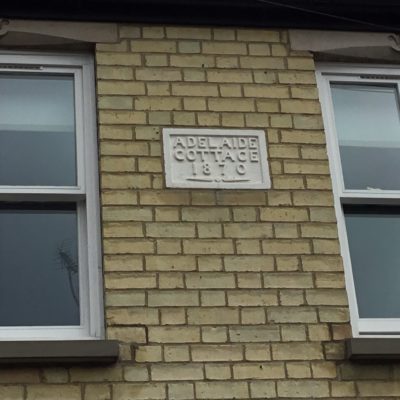Search by topic
- archaeology
- architecture
- bricklayer
- Building of Local Interest
- carpenter
- church
- crime
- dressmaker
- fire
- Great Eastern Railway
- listed building
- medieval
- oral history
- Public House
- Rattee & Kett
- Religious House
- Roman
- scholar
- school
- Then and Now
- tudor
- women
- work
- world war one
- world war two
Search by text
63 Ainsworth Street
63 Ainsworth Street
Number 63 is one of a three terraced houses on the west side of Ainsworth Street.
1881 census
Gibbs Pate, head, 62, grocer’s assistant, b. Harlton, Cambridgeshire
Ellen Pate, wife, 60, b. Hilgay, Norfolk
Elizabeth Pate, daughter, 23, draper’s assistant, b. Cambridge
Thomas Pate, son, 22, boiler maker’s assistant on GER, b. Cambridge
Edward Pate, son, 17, carpenter’s apprentice, b. Cambridge
The Pate family moved here from Coronation Place.
Thomas Pate sailed to the USA in 1887 aboard the Lord Clive. He married Ellen in 1890 and they settled in New York, where Thomas worked as a tailor. He died in New York in December 1930.
Edward Pate (now known as Albert) stayed in Cambridge and married Laura Dodd in 1889. They had twin sons called Frederick and Albert. The 1891 census sees them living at the City Arms (now the Dobblers) on Sturton Street, where Edward Albert’s occupation was carpenter and publican. He died in 1892.
Elizabeth Pate married James Phillips, from 2 Upper Gwydir Street, in the summer of 1881. James died in 1889, aged 30. Elizabeth and her daughter Ellen moved back in with her parents, where she worked as a dressmaker. She married tailor Robert Beales in 1893, and they lived at 111 Sturton Street.
1891 census
Gibbs Pate, head, 71, no occupation, b. Harlton, Cambridgeshire
Ellen Pate, wife, 69, b. Hilgay, Norfolk
Elizabeth Phillips, daughter, 34, dressmaker, b. Cambridge
Ellen Phillips, granddaughter, 8, scholar, b. Cambridge
Saml G Pate, son, 29, petty officer, Royal Navy, b. Cambridge
Gibbs and Ellen Pate had moved to 31 Kingston Street by 1901. Gibbs died in 1905.
Their son Samuel Gibbs Pate was a Petty Officer, Second Class, in the Royal Navy, currently home on leave from HMS Serapis. He left the Navy in December 1900 and initially lived with his parents at 31 Kingston Street. Then, at the outbreak of war in 1914, he got married – to widow Alice Dunn – and joined up again. In May 1915, whilst serving at the Victory I (an accounting base at Portsmouth), he was invalided out with pneumonia.
Samuel and Alice settled down in Charles Street, along with Alice’s daughters, and were still living there at the time of the 1939 Register. Samuel died in 1943.
1901 census
Joe Wood, head, 39, house painter, b. Glossop, Derbyshire
Eliza Wood, wife, 35, b. Priors Hardwick, Warwickshire
Ann Etcher, boarder, widow, 83, college pensioner, b. Cambridge
1911 census
James Jarvis, 65, maker of embrocation & cleansing fluid, b. Brockley, Suffolk
Alice Jarvis, 63, b. Kedington, Suffolk
James and Alice had been married for 38 years. They had two children, one of whom had died.
The census states that James Pate’s ’embrocation & cleansing fluid’ was for publicans and general purposes. Embrocation (or liniment) is an older term for topical medicine sold to relieve muscular pain and arthritis. It typically contained a solvent such as alcohol or acetone (a ‘cleansing fluid’) along with an analgesic such as methyl salicylate or menthol.
1921 census
James Jarvis, head, 75, embrocation manufacturer, own account, b. Brockley, Suffolk
Andrew Bell, lodger, 35, fish salesman, Mac Fisheries, Petty Cury, b. Woburn Sands, Bedfordshire
Florence Mabel Bell, lodger, 26, no occupation, b. Cambridge
Sources: UK census records (1861–1921), UK Royal Navy Register of Seamen’s Services (1848-1939), Cambridgeshire, England, Electoral Registers, Burgess Rolls and Poll Books (1792-1966), Pennsylvania, Passenger and Crew Lists, (1800-1962), 1900 United States Federal Census, National Burial Index For England & Wales, England & Wales Marriages (1837-2005), WikiTree.com, Wikipedia.org
Contribute
Do you have any information about the people or places in this article? If so, then please let us know using the Contact page or by emailing capturingcambridge@
License
This work is licensed under CC BY-NC-SA 4.0









